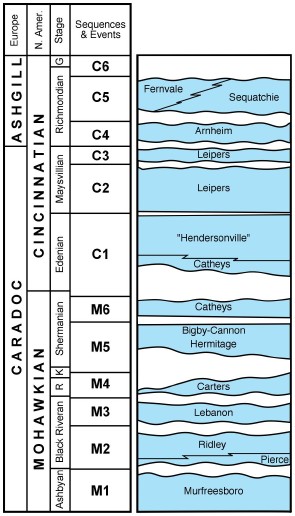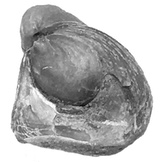Sequence Stratigraphy of the Nashville Ordovician: 3rd-Order Sequences

The Ordovician rocks of the Nashville Dome are divided into eleven large-scale depositional sequences. These are numbered from M1 to M6, for sequences largely within the Mohawkian Series, and from C1 to C5, for sequences largely within the Cincinnatian Series. Sequence C6, indicated on the chart to the left, is not present on the Nashville Dome, but is present on the Cincinnati Arch. These depositional sequences are typically between 1–10 m.y. long and are thus considered to be 3rd-order sequences. A depositional sequence (see Online Guide to Sequence Stratigraphy for more details about sequence stratigraphy) is an unconformity-bounded unit. Each of these sequences consists of a typically thin basal transgressive systems tract and an overlying thicker highstand systems tract. Lowstand systems tracts are unknown from these sequences on the Nashville Dome and suggest that sea-level fall at the sequence boundaries was sufficient to result in subaerial exposure of the carbonate platform. Recent studies of carbon isotopes and strontium concentration confirm this interpretation. By definition, facies within the transgressive systems tracts display a net deepening upward trend and those within the highstand systems tract form a net shallowing upward trend. Because these sequences are dominated by their highstand systems tracts, they are characterized predominantly by overall upward shallowing.
Because most of the Nashville lithostratigraphy is based originally on both lithologic and paleontologic criteria, most formational boundaries in the Nashville Ordovician coincide with sequence boundaries. Notable exceptions include the gradational shallowing-upward facies contact between the Pierce and Ridley Limestones, as well as the lateral intertonguing relationships between the Fernvale Limestone and the Sequatchie Formation. The contact between the "Hendersonville Shale" and the Catheys Formation, and the contact between the Hermitage and Bigby-Cannon Formations are placed at flooding surfaces, that is, an abrupt vertical change from relatively shallower-water facies to relatively deeper-water facies. Two sequence boundaries are found within formations, one within the Catheys Formation and one within the Leipers Formation. Both of these surfaces involve minimal lithologic and paleontologic change, and as such, were not recognized previously as formational boundaries.
These depositional sequences can be recognized throughout the eastern United States, including the Cincinnati Arch and the Valley and Ridge from eastern Tennessee to northern Virginia. A correlation chart of these sequences is available as a pdf download. These sequences may also be present beyond this region to Nevada and Estonia, based on recent work by Mark Harris and Pete Sheehan. The wide distribution of these sequences favors their formation through changes in eustatic sea level.

